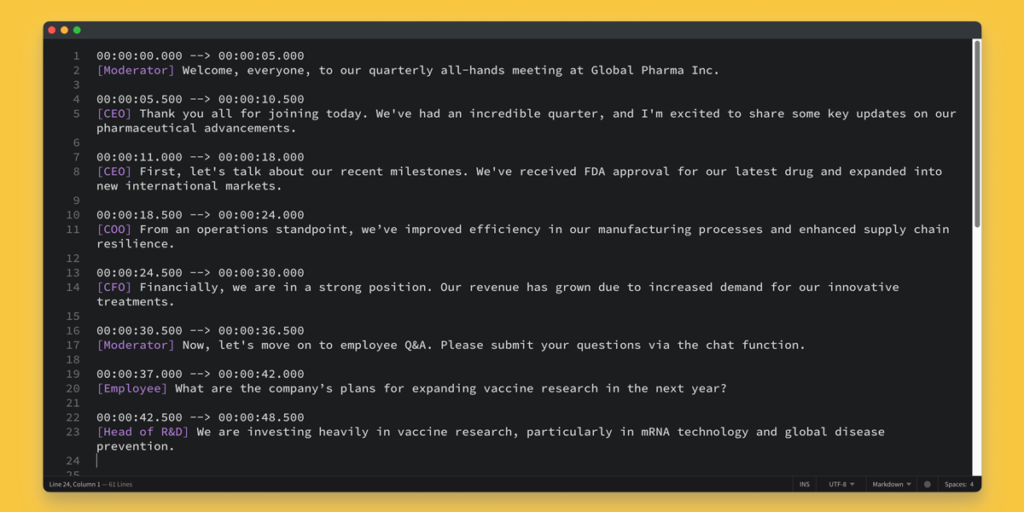Whether it’s an internal town hall or an external product launch, running a multilingual meeting or event requires specialized tools to ensure that information is captured accurately in each of the languages. Thankfully, with the advent of AI-translated transcripts, effective documentation is no longer an obstacle. But what exactly are AI-translated transcripts, and how can they transform the way we handle meeting and event summaries? Let’s dive in.

What Is Transcription?
First off, transcription is the process of converting spoken language into written text. This practice has been a cornerstone of documentation for decades, ensuring that spoken content from meetings, interviews, and events is accessible in a readable format. Traditionally, transcription from meetings, conferences, and events was done manually, which proved to be time-consuming and costly. However, with advances in AI technology, transcription has become faster, more accurate, and now available in multiple languages.
How does it work? AI-powered transcription tools use natural language processing (NLP) and machine learning algorithms to convert speech into text. These tools are capable of handling different accents and dialects, making them invaluable for multilingual events.
What Are the Best Formats for Multilingual Transcription?
Modern AI transcription platforms offer a range of options for how users can access their transcripts. After a meeting or event, users can download multilingual transcripts in a variety of formats to suit their needs:
- Plain Text (.txt): Ideal for simple note-taking and quick sharing.
- Word Documents (.docx): Perfect for editing and formatting meeting minutes or event summaries.
- PDF (.pdf): A professional format that ensures the content remains uneditable and visually consistent.
- Spreadsheet (.csv): A structured format often used for data analysis or reporting.
- Subtitles (.srt or .vtt): Useful for video content that requires multilingual captions.
These formats make it easy to integrate AI-translated transcripts into existing workflows, whether for documentation, sharing with stakeholders, or publishing.
KUDO’s AI-Translated Transcription
At KUDO, our specialized live translation and captioning platform offers transcription in .vtt file format for sessions using either human interpretation or AI speech translation, since this is most appropriate format for multilingual captions and subtitles.
Other key features of our transcription service include:
- Downloading the transcripts of both AI and human-interpreted meetings and events in each language.
- The meeting or event needs to be recorded to have the transcripts enabled.
- For human-interpreted meetings or events, clients must enable transcription for each session for security purposes
- Transcripts are available to be downloaded in .vtt format.
What is a .vtt File Format?
A VTT file (short for Web Video Text Tracks Format) is a file format used primarily for captions or subtitles in online video content. It follows the WebVTT standard, which is widely supported by modern video players and web browsers.
Key Features of .vtt Transcripts
- Timing Information: VTT files include timestamps to specify when each subtitle or caption should appear and disappear on the screen.
- Text Content: They contain the actual subtitle text displayed to the viewer.
- Styling Options: VTT files can include optional styling elements, such as italics, bold, or positioning.
- Metadata Support: Additional notes or speaker identifiers can be included for clarity.
Sample .vtt File Format
Here’s a quick example of what a .vtt file looks like, and what to expect from KUDO’s AI transcription service:

Why Does KUDO Use .vtt Files for Transcription?
- Broad Compatibility: Supported by platforms like YouTube, Vimeo, and HTML5 video players.
- Lightweight: Text-based format, making it easy to create and edit.
- Accessibility: Helps meet accessibility standards, such as ADA or WCAG, by providing captions.
- Multilingual Support: Easily create captions in multiple languages for the same video.
Most Popular Use Cases for AI-Translated Transcripts
At KUDO, we see our clients use live speech translation and captioning for diverse use cases. Where transcription is concerned, the most popular reasons why clients would want to access transcripts in multiple languages after their meetings and events include:
Internal Meetings
Global companies can use multilingual transcripts to ensure that all employees, regardless of location or language, understand key business discussions and decisions after the fact.
Conferences and Webinars
Organizers can provide downloadable transcripts to attendees, enhancing their value proposition and encouraging greater engagement.
Educational Institutions
Lectures, seminars, and workshops can benefit from AI-translated transcripts, allowing students to review and study content in their preferred language. This is particularly important in the United States considering growing accessibility mandates in higher education.
Public Sector and Legal Compliance
Finally, government meetings and public hearings can use multilingual transcripts to comply with accessibility regulations and promote transparency. And again, we are seeing an increase in regulations around citizen accessibility within local governments throughout North America and Europe, especially in light of mandates like Canada’s Official Languages Act.
Benefits of Multilingual Transcripts for Meeting and Event Summaries
To wrap things up, AI-translated transcripts are a game-changer for making meetings and events more accessible, efficient, and impactful. By leveraging this simple technology like KUDO’s, organizations can bridge language barriers and ensure their content reaches a global audience, while saving time working on post-meeting or event write-ups in multiple languages.
Here are some of the major benefits of investing in AI transcription:
1. Enhanced Accessibility
Multilingual transcripts ensure that participants, regardless of their preferred language, can access and understand the content of meetings or events. This inclusivity promotes better engagement and collaboration across diverse teams.
2. Accurate Documentation
Transcripts provide a detailed record of discussions, decisions, and action items. This level of accuracy is crucial for compliance, legal purposes, and historical records.
3. Time-Saving Summaries
With multilingual transcripts, creating summaries becomes a breeze. Organizers can quickly extract key points, quotes, and action items without having to listen to recordings repeatedly.
4. Increased Reach
Organizations can repurpose multilingual transcripts for blogs, social media posts, and newsletters, extending the reach and impact of their meetings or events.
5. Improved Team Collaboration
Sharing AI-translated transcripts across teams ensures everyone is on the same page, fostering transparency and reducing misunderstandings.